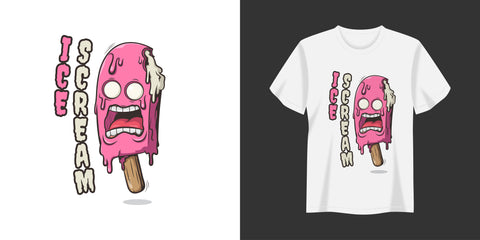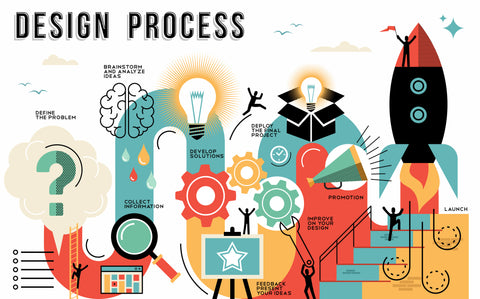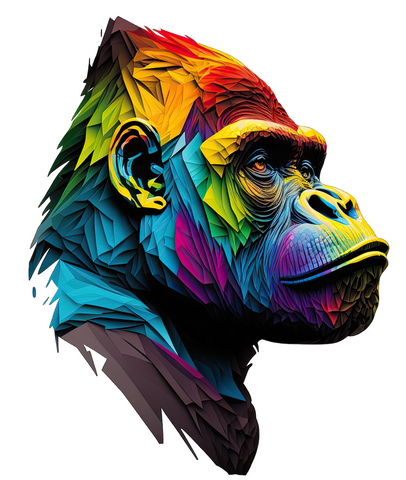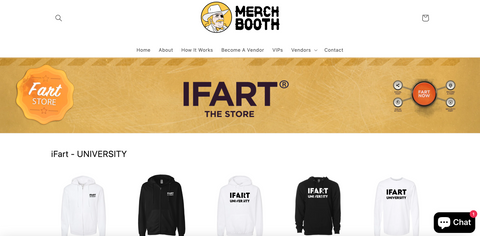Welcome, creative spirits, to a journey that will immerse you in the vibrant world of T-shirt design. In the sea of fashion and apparel, T-shirt design holds a special place - it's not just a form of expression but also a powerful medium for communicating ideas and identities. Whether it's the iconic "I ❤ NY" or your favorite band’s logo or merch line, T-shirts have the power to tell stories, evoke emotions, or simply make a statement.
The purpose of this guide is to unlock the secrets of successful T-shirt design. Whether you're an aspiring designer, an artist looking for a new canvas, or an entrepreneur ready to launch your own clothing brand, this comprehensive guide is your roadmap. From the fundamentals of design to the final stages of printing and selling, we will walk you through every step of the process.
This isn't just about learning the technical aspects - although they are important - but also about understanding the art and the heart that goes into creating a design that resonates with people. We will delve into the depths of creativity, learn how to spot trends, develop concepts, and communicate messages effectively.
As we embark on this journey, remember that great T-shirt design isn't just about skill but also about passion, creativity, and the ability to connect with people on a personal level. So, let's begin this exciting voyage into the world of T-shirt design. Let’s bring your ideas to life and create designs that leave a lasting impression.

Understanding the T-shirt Design Basics
Welcome to the world of T-shirt design, a fascinating place where artistry and practicality unite. In this section, we’ll delve into the fundamental principles that underpin effective T-shirt designs. Grasping these basics is akin to learning how to walk before you can run - vital for anyone starting their design journey.
T-shirt Design Principles
The principles of T-shirt design aren't much different from other forms of visual design. They revolve around balance, emphasis, movement, pattern, repetition, proportion, rhythm, variety, and unity. In essence, these elements work together to create designs that are aesthetically pleasing and communicate effectively. Remember, a well-designed T-shirt is a symphony of these principles in harmony.
Different Styles of T-shirt Design
Like music, T-shirt design has various genres - from minimalist to grunge, typography-based to illustrative, retro to futuristic, and so much more. Your design style could be a single genre or a mix, creating a unique blend that reflects your individuality. Exploring different styles can help you discover what resonates with you and, importantly, with your target audience.

Impact of Color and Typography in T-shirt Design
Color and typography are the heart and soul of your T-shirt design. They can stir emotions, shape perceptions, and create a visual rhythm. Colors speak volumes about a brand or message, while typography can set the tone and character of the design. Understanding the psychology of colors and the nuances of typography is crucial to create designs that engage and inspire.
Importance of Balance and Proportions
Balance and proportions play an integral role in making your design pleasing to the eye. Whether it's a symmetrical design radiating equilibrium or an asymmetrical one sparking dynamic interest, achieving balance ensures your design feels cohesive and harmonious. And proportions? They’re the unseen glue holding your design together, keeping it from feeling overwhelming or sparse.
Grasping these fundamental aspects will help you create T-shirt designs that not only look stunning but also communicate effectively. It's an exciting process of learning and discovery, where each design you create brings you one step closer to mastering the art of T-shirt design. So, let's keep the creative juices flowing and take the plunge into the captivating process of idea generation and conceptualization in the next section. Buckle up! Your design adventure is just beginning.
Idea Generation and Conceptualization
Now that we have our design foundation set, let's venture into the thrilling realm of idea generation and conceptualization. This stage is where creativity takes flight, allowing the magical blend of imagination and strategy to breathe life into your design.
Finding Inspiration for T-shirt Designs
Inspiration is all around you - it can come from a random scribble, an evocative quote, a captivating sunset, or a beautifully designed coffee cup. It can be found in art, nature, books, movies, music, cultures, history, and the list goes on. The key is to keep your mind open, be curious, and see the extraordinary in the ordinary. Remember, inspiration isn’t about copying, but about sparking ideas that lead to unique creations.

Brainstorming Techniques
Brainstorming is an invaluable tool in your design journey. Whether you prefer mind maps, word lists, or the SCAMPER technique (Substitute, Combine, Adapt, Modify, Put to another use, Eliminate, Reverse), brainstorming can help you explore numerous ideas and possibilities. Don't be afraid to think outside the box, and remember, there's no such thing as a bad idea in a brainstorming session.
Developing and Refining Design Concepts
With a pool of ideas, it's time to develop your concepts. Sketch, doodle, play with colors and typography, and don't be afraid to make changes or even start over. This phase is all about refinement - trimming the excess, enhancing the elements that work, and polishing your idea until it shines.

Cultural and Trend Considerations in T-shirt Design
Being aware of cultural symbols and trends can add depth and relevance to your designs. However, it's important to use them respectfully and thoughtfully. Likewise, staying abreast of design trends can help your designs feel fresh and current, but remember, trends come and go - authenticity and originality never go out of style.
Conceptualizing a T-shirt design is an exciting journey of discovery, filled with creativity and critical thinking. The aim is to develop a design that's not only visually stunning but also emotionally resonant and meaningful. So let your imagination run wild, and let the spirit of creativity guide you to your next iconic T-shirt design. Keep going, you're doing brilliantly! Up next, we'll delve into the key elements that make a T-shirt design truly effective.
Key Elements of Effective T-shirt Design
With our creative engines in full swing and a plethora of ideas at hand, it's time to delve deeper into what makes a T-shirt design truly stand out. Let's explore the key ingredients that concoct a design worth remembering.
Importance of Simplicity and Clarity
In the world of T-shirt design, simplicity often equates to effectiveness. A design that's easy to understand at a glance can have a stronger impact than one that's overly complicated. Clarity in your message and design elements is crucial - it's about making every line, color, and typeface count. Remember, sometimes less really is more.
Use of Humor, Slogans, or Symbols
Humor, catchy slogans, and recognizable symbols can make your T-shirt design memorable. They create an emotional connection, evoke a response, and make your design shareable - who doesn't love a good laugh or a powerful quote that resonates? Just make sure your humor is in good taste and your symbols and slogans are culturally appropriate and respectful.

Check out the iFart Tshirt store on MerchBooth for more examples of humor in Tshirt design
Role of Creativity and Originality
In a world full of T-shirts, what will make yours stand out? The answer lies in creativity and originality. Embrace your unique perspective and don't be afraid to break the rules sometimes. A truly original and creative design can be a breath of fresh air, capturing attention and leaving a lasting impression.
Understanding the Target Audience
Knowing your audience is crucial. It influences your design's style, colors, typography, humor, and overall messaging. Research and understand their preferences, interests, and values. A design that speaks directly to your audience can resonate on a deeper level, creating a stronger connection and sparking engagement.
The elements of simplicity, humor or powerful symbols, creativity, and audience understanding blend together to create a T-shirt design that's not just visually appealing but also emotionally captivating. These are the designs that people love to wear, share, and remember. So go ahead, take these ingredients and cook up your next masterpiece! And remember, with each design you create, you're not just designing a T-shirt, but you're telling a story, conveying an emotion, and creating a piece of wearable art. Let's move on to the next step in your design journey: the tools and techniques of T-shirt design. Ready? Let's go!
Tools and Techniques for T-shirt Design
As we journey further into the realm of T-shirt design, it's time to get our hands on the tools and techniques that will bring your creative vision to life. Think of these as your paintbrushes and color palettes, ready to turn the canvas of a T-shirt into a masterpiece.
Overview of Design Software
In today's digital age, design software tools like Adobe Illustrator and Photoshop have become essential for T-shirt design. Illustrator, with its vector-based system, is perfect for creating clean, scalable designs. Photoshop, on the other hand, excels in detailed image manipulation and is often preferred for more complex, textured designs. Other popular alternatives include CorelDraw and free options like GIMP and Inkscape. Each tool has its strengths, so choose one that suits your design style and needs.
Basic Techniques and Tutorials for Beginners
Every great designer starts with the basics. Learn the essential functions of your chosen design software: how to set up your workspace, use layers, manipulate shapes and lines, apply colors, and work with text. Many tutorials are available online, so take advantage of these resources. Practice regularly, and remember, patience is your best friend during this stage.
Advanced Techniques for More Complex Designs
Once you're comfortable with the basics, delve into more advanced techniques like shading, texturing, and 3D effects. You can also explore digital drawing and illustration if your style leans more towards hand-drawn designs. Remember, learning is a journey - take one step at a time and don't be disheartened if things seem tough initially. The more you practice, the better you get.

Introduction to Hand-drawn Designs
Hand-drawn designs bring a unique, personal touch to your T-shirts, and with the right tools, you can easily digitize your sketches. You can use a scanner to import your drawings into your design software, or you could use a digital drawing tablet for a more direct approach. Hand-drawn designs can add a lovely organic feel that sets your design apart.
With the right tools and techniques, your imagination is the only limit to what you can create. While software and techniques are important, remember that they're just tools to help you express your creativity. So, stay curious, keep learning, and most importantly, enjoy the process. Up next, we'll look into preparing your designs for printing – the stage where your digital design transforms into a tangible, wearable piece of art.

How to Prepare Your Design for Printing
Ah, the moment of transformation! Your creative journey now leads us to the stage where your digital design metamorphoses into a tangible, wearable form. It's a thrilling prospect, but it also requires careful preparation to ensure the best possible outcome. Fear not, though, as we're here to guide you every step of the way.
Understanding Different Printing Methods
Various printing methods exist, each with its pros and cons. The two most common are screen printing and direct-to-garment (DTG) printing. Screen printing, an age-old technique, is excellent for large orders and solid color designs, while DTG printing, a more modern method, excels in delivering intricate, multi-colored designs but is better suited for smaller quantities. Understanding which method best suits your design and requirements is crucial to ensure a high-quality print.
Setting up Files for Printing
This is where your design takes its final form. It's essential to set up your files correctly to avoid any printing mishaps. Always work in high resolution (usually 300 DPI is recommended), ensure your design is the correct size, and save your files in a print-friendly format, typically .EPS, .PDF, or .AI for vector designs, and .TIFF or .PSD for raster designs. Always check with your printer for their specific requirements.
Colors and Printing - Pantone, CMYK, RGB
Understanding color systems is crucial for accurate color reproduction. Pantone colors are often used in screen printing for exact color matching, while DTG printers use the CMYK system. Also, it's important to remember that colors can appear differently on a screen (RGB) than when printed (CMYK), so always do a test print if possible.
Pre-printing Checklist
Before you send your design off for printing, double-check everything. Is the resolution high enough? Is the design correctly sized? Are the colors set up correctly? Is the file format compatible with your printer's requirements? And very importantly, have you proofread any text in your design? A thorough check can save you from unnecessary errors and revisions.
Preparing your design for printing might seem a little daunting, but it's an essential part of the process. And remember, every new skill you learn and every challenge you overcome is a stepping stone on your journey to becoming a master T-shirt designer. Up next, we’ll explore how to work with printers and manufacturers to bring your T-shirt designs to life. Let's forge ahead, shall we?
Working with Printers and Manufacturers
Having prepared your designs for printing, the next step is to collaborate with the people who will physically create your T-shirts. This stage may feel a little out of your hands, but fear not - there's plenty you can do to ensure the process goes smoothly and the results are just as you envisioned.
Check out MerchBooth for an all-in-one t-shirt printing solution.

Choosing the Right Printer or Manufacturer
Selecting the right printer or manufacturer is like choosing a dance partner - you need to move together harmoniously. Look for providers who have a strong reputation, quality samples, and good customer service. Whether you opt for a local printer or an online print-on-demand service, it's essential to find a partner who understands your vision and can bring it to life faithfully.
If you'd prefer to have everything handled for you, from selecting the proper high quality garments to printing and selling online make sure to check out MerchBooth.com.

Understanding T-shirt Materials and Quality
T-shirts may seem like simple garments, but a lot goes into creating one. The fabric, weight, and weave all affect how your design will look when printed. Cotton is a popular choice for its breathability and printing capabilities, but blends or synthetic materials might be more suitable for certain designs or uses. Make sure to consider these factors and consult with your manufacturer about what's best for your specific design.
Check out the MerchBooth material guide:
Communicating Effectively with Your Printer
Communication is key in any collaboration, and this holds true when working with your printer. Provide clear instructions about your design, its placement, the colors used, and the printing method you prefer. Ask for a sample or a proof before the entire batch is printed. Remember, it's better to clarify any uncertainties upfront than to be disappointed with the final product.
Handling Revisions and Errors
Despite all your careful planning, things may not always go as expected. Misprints happen, colors may not look quite right, or the print may not be as sharp as you hoped. The key is not to panic - instead, communicate the issues to your printer calmly and clearly. They're there to help you, and most will be more than willing to correct any errors.
Working with printers and manufacturers may seem daunting at first, but remember, they are partners in your creative journey. With clear communication, thorough research, and a bit of patience, you can navigate this stage smoothly and get the beautiful, high-quality T-shirts you envision. But our journey doesn't end here - next, we'll explore the final and equally exciting part of your T-shirt design adventure: marketing and selling your designs. Ready to conquer the world with your T-shirts? Let's go!
Marketing and Selling Your T-shirt Designs
Congratulations, your design journey has brought you to the thrilling stage of marketing and selling. With your T-shirts now a reality, it's time to share them with the world. Remember, your T-shirts are not just products, but wearable stories, and you're about to become the storyteller.
Identifying Your Target Market
Before you can sell your T-shirts, you need to know who you're selling to. Identifying your target market is crucial for effective marketing. Understand their likes, interests, values, and shopping habits. Are they young, trendy, and online-savvy, or are they more mature, traditional, and prefer shopping in stores? This understanding will help you tailor your marketing strategy to reach and appeal to your audience effectively.
Creating a Strong Brand
Your brand is more than just your logo or tagline - it's the overall image and feeling that your T-shirts convey. A strong brand can create a loyal customer base and distinguish you from competitors. Think about what your T-shirts represent and the message you want to send. Is it fun, edgy, inspirational, or maybe environmentally conscious? Your branding should reflect this consistently across all channels.
Online Marketing and Selling Strategies
In today's digital world, online marketing is a powerful tool. Social media, email newsletters, SEO, and pay-per-click advertising can reach a vast audience. Selling can be done through online marketplaces, like, MerchBooth, Etsy or Amazon, or you can set up your own website. Be sure to utilize high-quality photos of your T-shirts, engaging product descriptions, and customer testimonials to effectively showcase your products.
Offline Marketing and Selling Strategies
Don't forget the power of offline marketing and selling. Participate in local markets or pop-up shops, collaborate with local businesses, or organize events. Networking can also be highly beneficial - the more people who know about your T-shirts, the wider your potential customer base.
Selling and marketing your T-shirt designs might seem challenging, but it's an exhilarating part of your design journey. This is where you get to see your hard work pay off as people around the world wear and appreciate your designs. Remember, every successful sale is a testament to your creativity and hard work, and every challenge is an opportunity to learn and grow. So here's to your success in the exciting world of T-shirt design – may your creativity shine bright and your T-shirts be worn with pride!
That concludes our comprehensive guide on T-shirt design. We hope this journey has been informative and inspiring, sparking your creativity and equipping you with the knowledge you need to create stunning T-shirt designs. Remember, the world of T-shirt design is one of endless possibilities - so let your imagination run wild, embrace your unique style, and above all, enjoy the process.
Legal Considerations in T-shirt Design
As we embark on this creative journey, it's crucial to remember that our flight of imagination must also navigate the important realm of legal considerations. Ensuring your T-shirt designs respect the law doesn't just keep you safe from potential legal disputes, but it also fosters fair play and respect in the creative world. Let's explore some key points to keep in mind.
Intellectual Property Rights
When drawing inspiration for your designs, be mindful not to infringe on anyone else's intellectual property rights. This includes logos, copyrighted images, trademarked slogans, or distinct visual elements from a recognizable brand. It's essential to create original work and to respect other creators' rights.
Fair Use and Parody
In some cases, copyrighted material can be used under the 'fair use' doctrine, which permits limited use of copyrighted material without permission. However, what constitutes fair use can be complex and is often decided on a case-by-case basis. Parody, a humorous or satirical commentary, can sometimes fall under fair use, but it's a gray area. When in doubt, consult with a legal expert.
Licensing and Permissions
If you wish to use someone else's artwork, design, or character, obtaining proper licensing and permissions is the ethical and legal way to go about it. This usually involves paying a fee and ensuring the owner's rights are respected.
Your Own Protection
Lastly, consider protecting your own designs, especially if they become popular. Copyright, trademark, or design patent can offer legal protection against unauthorized use.
Navigating legal considerations may seem daunting, but remember, it's an essential part of responsible and ethical design practice. It ensures respect for all creators and helps maintain a vibrant and fair creative community. If ever in doubt, it's best to seek legal advice. After all, in the world of T-shirt design, originality isn't just about creativity, it's also about respecting the law.
Final Thoughts
Congratulations on completing this journey through the fascinating landscape of T-shirt design! We've navigated together from the birth of a design idea, through the intricate creative process, mastering essential tools, prepping for printing, partnering with manufacturers, marketing your creations, and understanding the vital legalities. Remember, this guide is your compass, but the journey and destination are uniquely yours. Keep your curiosity alive, your creativity flowing, and your respect for the artform and fellow artists at heart. And most importantly, enjoy every step of this creative journey. Here's to creating T-shirts that make the world a more colorful, expressive, and inspiring place. Happy designing!
Resources and References
As we wrap up this guide, remember that the learning and exploration doesn't end here. There are countless resources available to help you delve deeper into the art of T-shirt design. Online platforms like Skillshare, Coursera, and YouTube offer numerous design tutorials. Websites like Behance and Dribbble are great for inspiration. Forums such as Reddit's /r/graphic_design can provide community support and advice. Books like "Vector Basic Training" by Von Glitschka or "Graphic Design School" by David Dabner can enrich your understanding. Always keep learning, keep exploring, and keep creating. Your T-shirt design adventure has just begun. Good luck!
Frequently Asked Questions on T-shirt Design
What is this guide about?
This comprehensive guide covers everything from the history of T-shirt design to creating, printing, and marketing your own T-shirt designs. It’s a one-stop resource for anyone interested in learning about the art of T-shirt design.
Who is this guide for?
This guide is for anyone interested in T-shirt design. Whether you're a complete beginner looking to start a new hobby or an established designer looking to refine your skills, this guide provides insightful and practical information.
Do I need any special software to design a T-shirt?
Not necessarily. You can start designing T-shirts using basic software like Microsoft Paint or even hand-drawn sketches. However, for more complex designs and better printing results, professional design software like Adobe Illustrator or Photoshop can be beneficial.
What is the best method for printing T-shirt designs?
The best printing method depends on your design and quantity. Screen printing is excellent for larger orders and solid color designs, while direct-to-garment (DTG) printing is great for intricate, multi-colored designs in smaller quantities.
How can I sell my T-shirt designs?
There are several ways to sell your T-shirt designs. You can sell them through online marketplaces like MerchBooth.com (preferred), Etsy or Amazon, or set up your own website. Offline strategies include local markets, pop-up shops, or collaborations with local businesses.
How do I ensure my designs do not infringe on intellectual property rights?
Always create original work and respect other creators' rights. Avoid using logos, copyrighted images, trademarked slogans, or distinct visual elements from a recognizable brand without proper licensing or permission.
Are there any resources for further learning and inspiration?
Yes, there are many resources available online, such as design tutorials on Skillshare, Coursera, and YouTube. Websites like Behance and Dribbble offer design inspiration. You can also read books like "Vector Basic Training" by Von Glitschka or "Graphic Design School" by David Dabner. Also check out the MerchBooth resource center for Education on Selling Merch and Screen Printing Resources.

